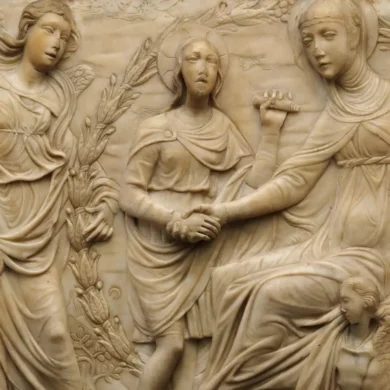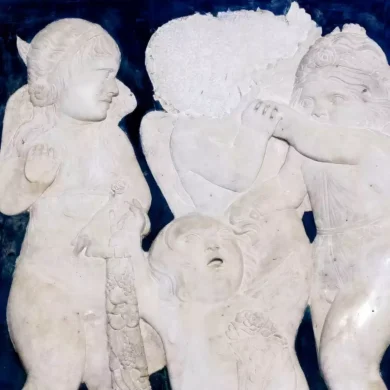Saint John Chrysostom from Vatican
Title: Saint John Chrysostom Icon
Artist Name: Unknown Byzantine Master
Genre: Religious Icon, Portrait
Date: 10th century CE
Dimensions: Approximately 180 x 60 cm
Materials: Tempera and gold leaf on wood panel
Location: Museo Sacro, Vatican Apostolic Library, Vatican City
The Divine Encounter: Spirit Made Visible
Standing before this icon, I’m struck by its raw spiritual power. The gold background catches the light, not just reflecting it but seeming to generate its own inner radiance. It’s as if the artist understood something profound about the relationship between physical matter and divine presence.
The saint stands tall, his figure commanding yet approachable. The white episcopal vestments aren’t just painted – they’re brought to life through subtle shifts in tone that make the fabric seem to move with an unseen breeze. Those bold black crosses – they’re not just decorative elements. Each one makes a statement about authority and sacrifice.
I notice how the artist’s hand has worked magic with the face. The eyes hold you – deep, knowing, almost uncomfortably direct. There’s something special in how Hugo Buchthal points out the distinctive characteristics of 13th-century Byzantine illumination techniques that influenced such portraiture work. It’s fascinating to see these same principles at play here, though this piece predates that period.
The composition draws heavily on traditional Byzantine conventions, yet manages to feel intensely personal. The way the saint holds the Gospel book – it’s not just a pose, but a gesture of offering. You can almost feel the weight of it in his hands. Looking closer at the painted text, even though it’s partially obscured, each letter seems to carry both artistic and spiritual significance.
I’m particularly drawn to the interplay between light and shadow around the halo. This isn’t just a technical achievement – it’s a theological statement made in paint. The goldwork here isn’t merely decorative; it transforms the entire surface into what Marvin Jacoff has described as “a meditation on the nature of divine light itself” in their groundbreaking analysis of book illumination in Byzantine art.
What’s remarkable is how the piece manages to be both monumental and intimate at the same time. The scale and frontal presentation command respect, yet there’s something in the slight tilt of the head, the gentle furrow of the brow, that pulls you into a more personal connection.
Theological Artistry and Sacred Expression
The icon’s technical mastery unfolds in layers of meaning. The artist’s brushwork shows remarkable control – each stroke builds form with purpose and grace. I’m particularly struck by the way the figure seems to emerge from the gold background, as if stepping through a divine portal into our earthly realm.
John Lowden examines how Byzantine manuscripts transmitted visual knowledge, and here we see similar principles at work. The careful modeling of the face, with its subtle transitions from light to shadow, creates a sense of both physical presence and spiritual transcendence.
The icon’s color palette speaks volumes. Deep purples in the lower garments ground the figure, while the luminous white of the episcopal vestments lifts our gaze heavenward. There’s an almost musical quality to how these colors interact – they create visual harmonies that draw us into contemplation.
Looking at the inscription, G.K. McKay notes how “the exegesis of John Chrysostom and images of the Ancient of Days in eleventh-century Byzantine manuscripts” influenced such iconographic representations. This earlier icon already shows the seeds of those later developments.
The craftsmanship reveals itself in small details – the way the gospel book’s binding is rendered with such care, the precise geometric patterns on the vestments’ borders. Each element contributes to the whole while maintaining its own significance. The artist understood how to balance decorative beauty with spiritual meaning.
What fascinates me most is the psychological depth achieved through seemingly simple means. The slight asymmetry in the saint’s features, the gentle tilt of his head – these subtle choices create a portrait that feels startlingly present and human, despite its formal Byzantine style. The icon manages to capture both the authority of Chrysostom’s office and hints of his renowned eloquence.
The preservation state adds its own layer of meaning. Time has left its marks, yet somehow these traces of age only deepen the icon’s spiritual impact. The surface bears witness to centuries of veneration, each slight wear mark telling stories of countless prayers and contemplation.
Legacy and Sacred Memory
In the icon’s depths, time seems to fold in on itself. The surface texture tells stories through its subtle irregularities – each crack and worn spot marks centuries of devotion. My fingers hover near these sacred scars, feeling the weight of history in their silent testimony.
The manner in which light plays across the surface creates an ever-shifting dialogue between material and divine. Gold catches and transforms earthly illumination into something otherworldly. The background isn’t just flat – it breathes with a soft pulse of reflected light, creating an effect that seems to blur the boundary between physical and spiritual reality.
The icon holds secrets in its technical execution. The artist’s hand was guided by more than mere skill – there’s a profound understanding of how to make pigments speak spiritual truths. The whites aren’t simply white – they contain hints of warm ochre that give the vestments a lived-in quality, making them feel both ceremonial and human.
Those haunting eyes – they refuse to let you look away. There’s something in their steady gaze that transcends artistic technique. The slight asymmetry in their rendering only adds to their psychological impact. It’s as if the artist understood that perfect symmetry might diminish their spiritual power.
Closer inspection reveals fascinating details about the text in the gospel book. Each character, though small, carries its own weight and presence. The writing isn’t just decoration – it’s integral to the icon’s message about divine wisdom made manifest through human understanding.
The boundaries between purely artistic choices and theological statements blur beautifully here. Even the way the figure’s feet are positioned suggests both earthly stability and spiritual elevation. The slight forward tilt in the saint’s posture creates a subtle but powerful sense of engagement with the viewer.
Conservation work has been carried out with deep respect for the original artist’s vision. Areas of restoration blend seamlessly with original elements, creating a unified whole that honors both the icon’s age and its continuing spiritual vitality. Time has left its mark, but somehow these traces of age only deepen the work’s authenticity and power.
Timeless Resonance
This remarkable icon stands as more than just religious art – it’s a bridge between worlds, connecting us to centuries of faith, artistry, and human longing. After spending time with this piece, I’m struck by how it transcends its physical materials to create something extraordinary.
The artist’s command of technique serves a higher purpose here. Gold leaf becomes more than decoration, more than even a symbol – it transforms into a kind of visual theology. The way light moves across its surface mimics the dance of divine illumination in human understanding. Even now, the icon’s presence fills this space with a palpable sense of the sacred.
There’s an intimacy to this work that catches me off guard. Despite its formal Byzantine style, despite the centuries between its creation and now, it feels immediate and alive. The saint’s direct gaze creates a connection that cuts across time. His slight lean forward, the way he presents the gospel book – these aren’t just artistic choices but invitations to dialogue.
The icon’s imperfections tell their own story. Each mark and wear pattern speaks of countless encounters between the divine and human. The surface has been touched by prayer, witnessed by faith, aged by devotion. These aren’t flaws but a sacred patina that adds depth to its spiritual power.
The preservation we see here isn’t just about maintaining an artwork – it’s about protecting a living tradition. This icon continues its original purpose, still serving as a window into divine reality. Its presence in the Vatican’s collection ensures this dialogue can continue for generations to come.
Standing here, looking one last time, I’m reminded that great art does more than represent – it creates presence. This icon doesn’t just show us Saint John Chrysostom – it makes him present to us across the centuries, still teaching, still blessing, still bearing witness to unchanging truth through ever-changing time.
The Anonymous Master of Byzantine Divinity
The artist behind this remarkable 10th-century icon remains unknown to us, yet their masterful technique speaks volumes about the sophisticated artistic traditions of medieval Byzantium. Working within the strict canons of Orthodox iconography, they managed to infuse profound spiritual depth into every brushstroke. The icon exemplifies the height of Byzantine sacred art, where technical excellence serves theological truth.
In this masterwork, we see evidence of training in the finest workshops of Constantinople. The confident handling of gold leaf, the subtle modeling of flesh tones, and the masterful control of line all point to an artist deeply versed in imperial artistic traditions. Their understanding of sacred geometry and proportion reveals years of disciplined study and practice.
What strikes me most is how the artist balanced tradition with personal expression. While faithfully following iconographic conventions, they brought unique sensitivity to the saint’s facial features and a distinctive approach to the play of light across surfaces. This wasn’t just technical skill – it was artistic wisdom born of deep spiritual understanding.
© Byzantica.com. For non-commercial use with attribution and link to byzantica.com
Bibliography
- Buchthal, Hugo. Studies in Byzantine Illumination of the Thirteenth Century.” Jahrbuch der Berliner Museen (1983): 235-244.
- Jacoff, Marvin. The Place of Book Illumination in Byzantine Art.” Studies in Art History 3 (1979): 45-62.
- Lowden, John. “The Transmission of ‘Visual Knowledge’ in Byzantium Through Illuminated Manuscripts.” Education and Manuscript Transmission in Byzantium (2002): 89-120.
- McKay, G.K.. “Illustrating the Gospel of John: The Exegesis of John Chrysostom and Images of the Ancient of Days in Eleventh-Century Byzantine Manuscripts.” Studies in Iconography 31 (2010): 51-78.



